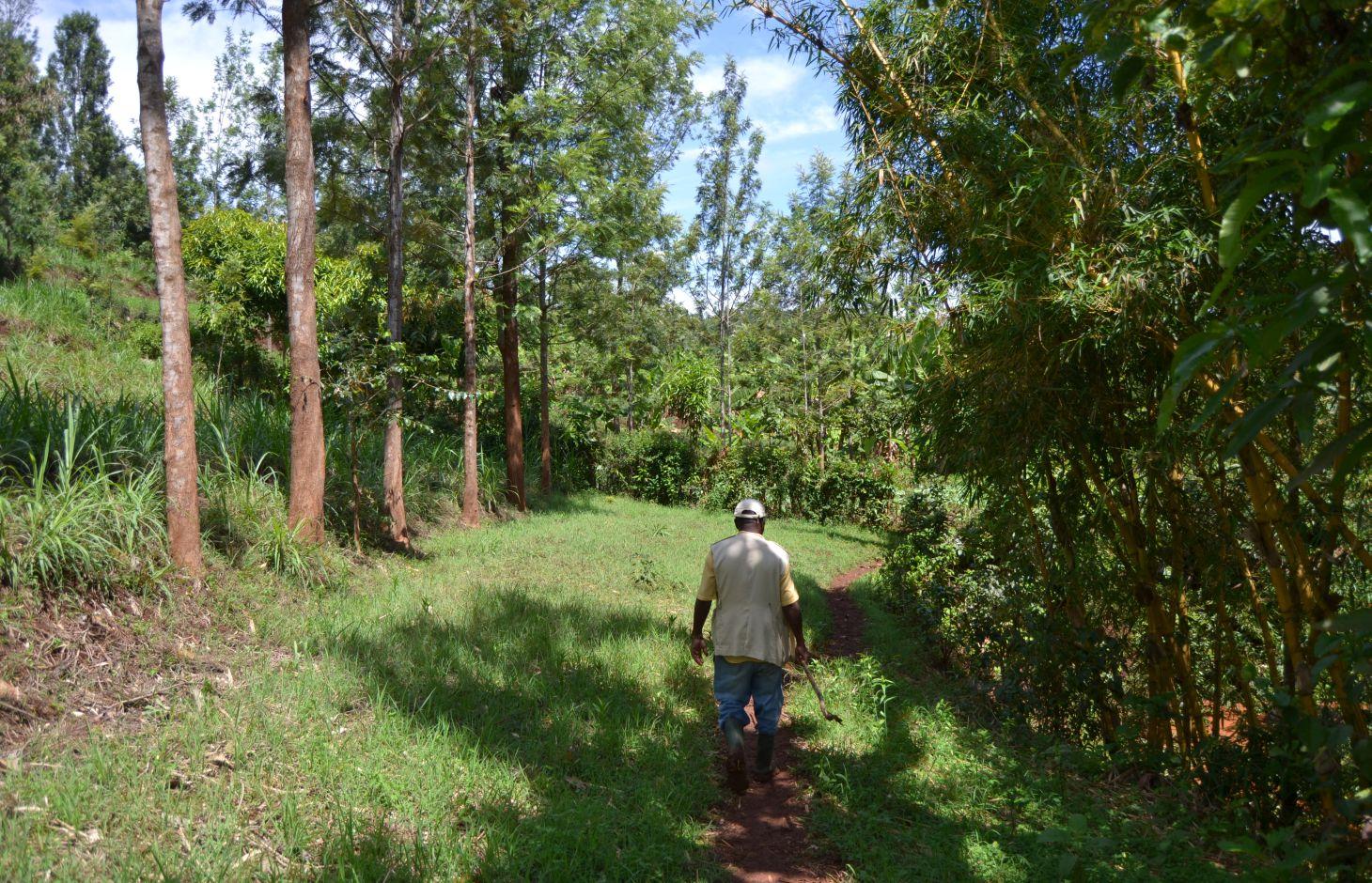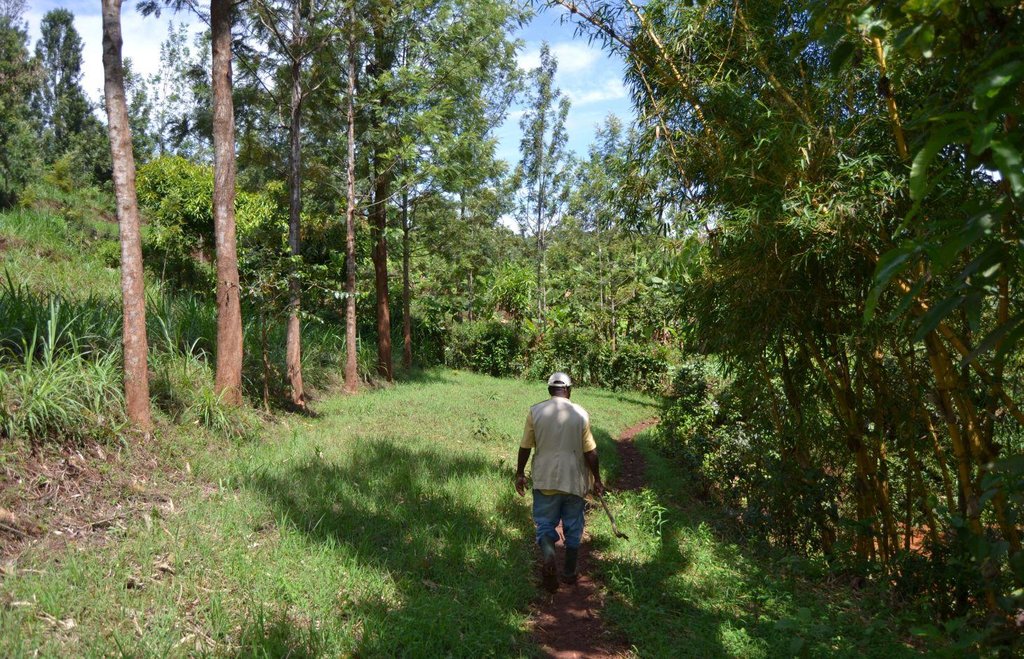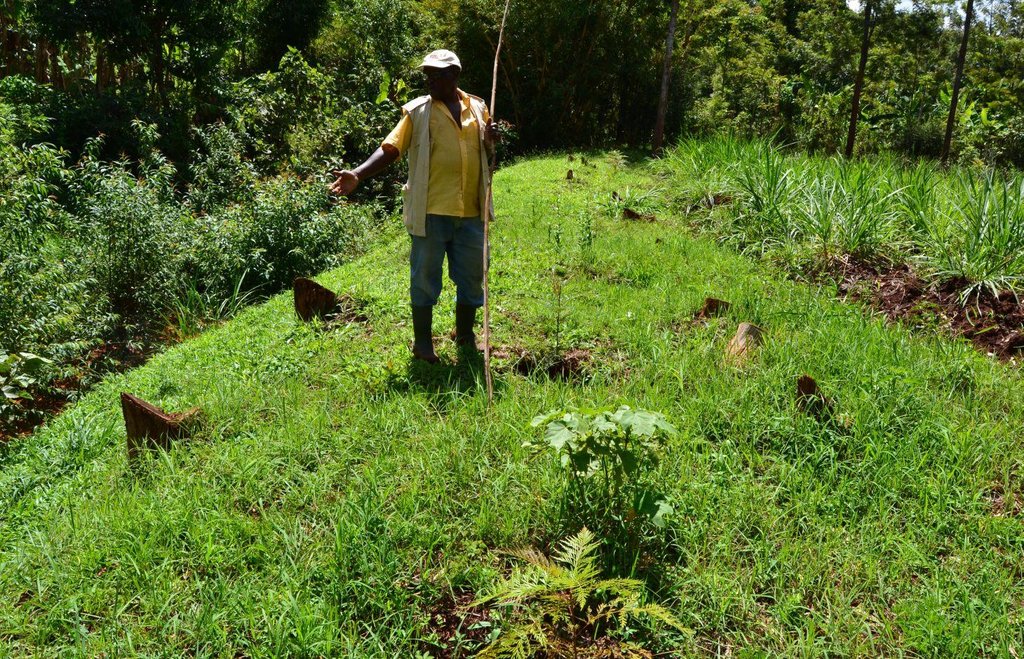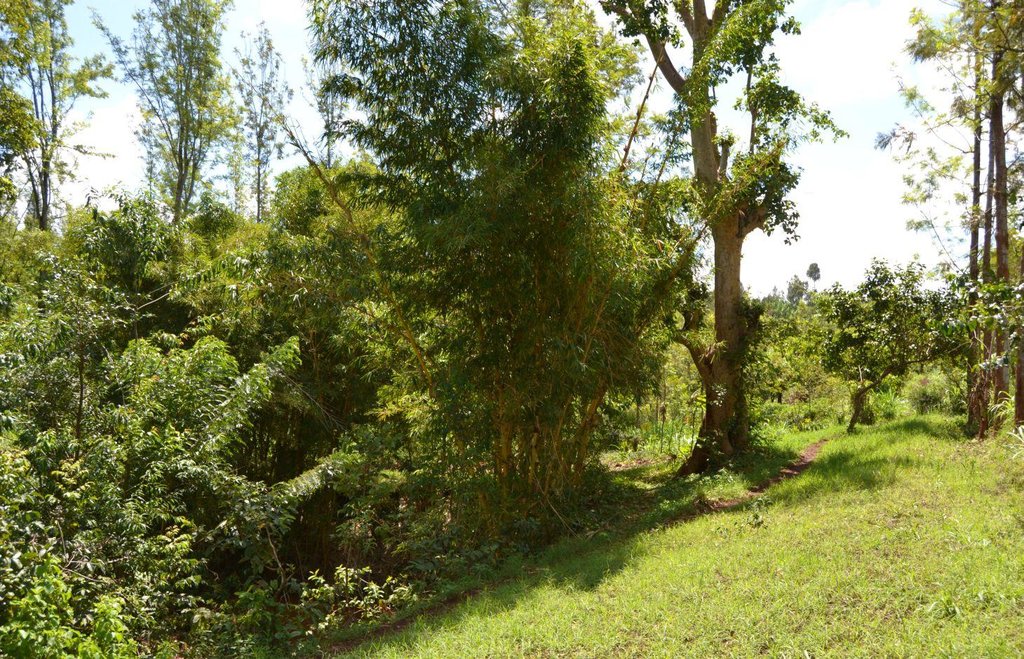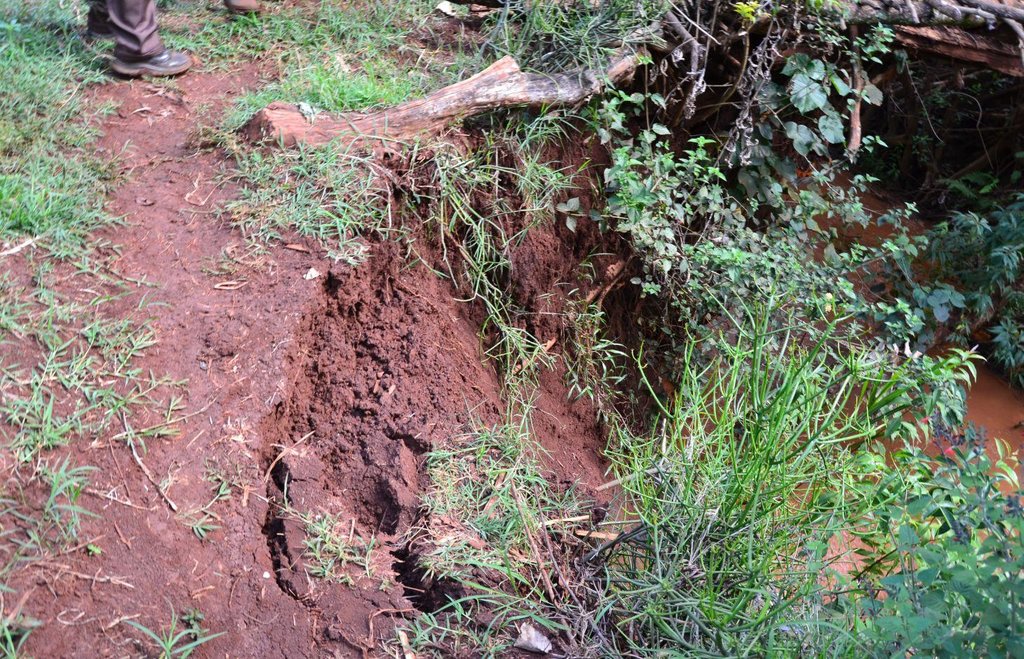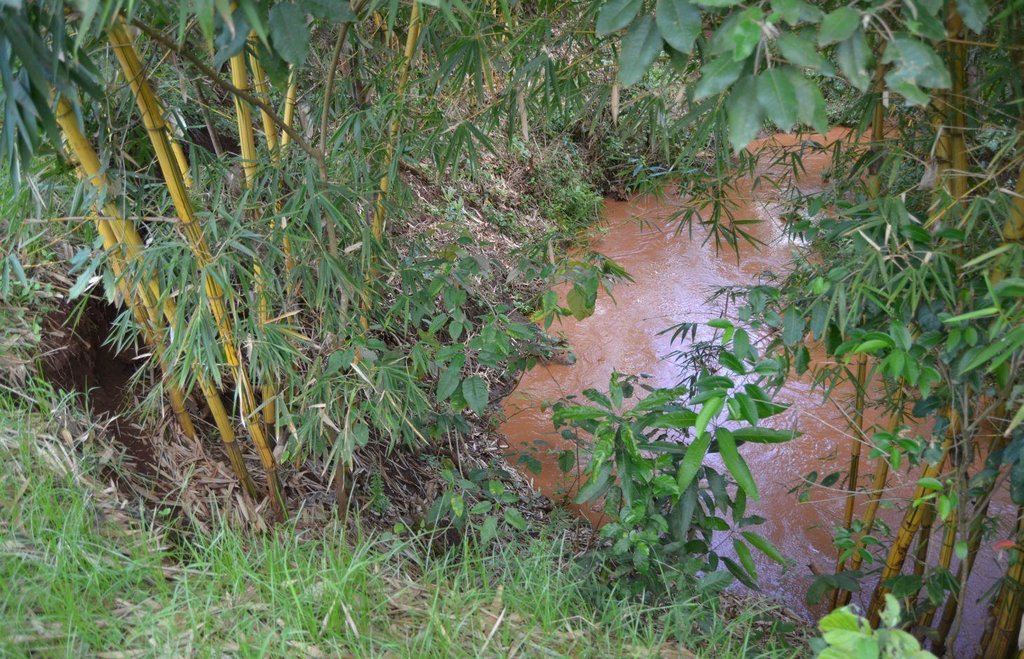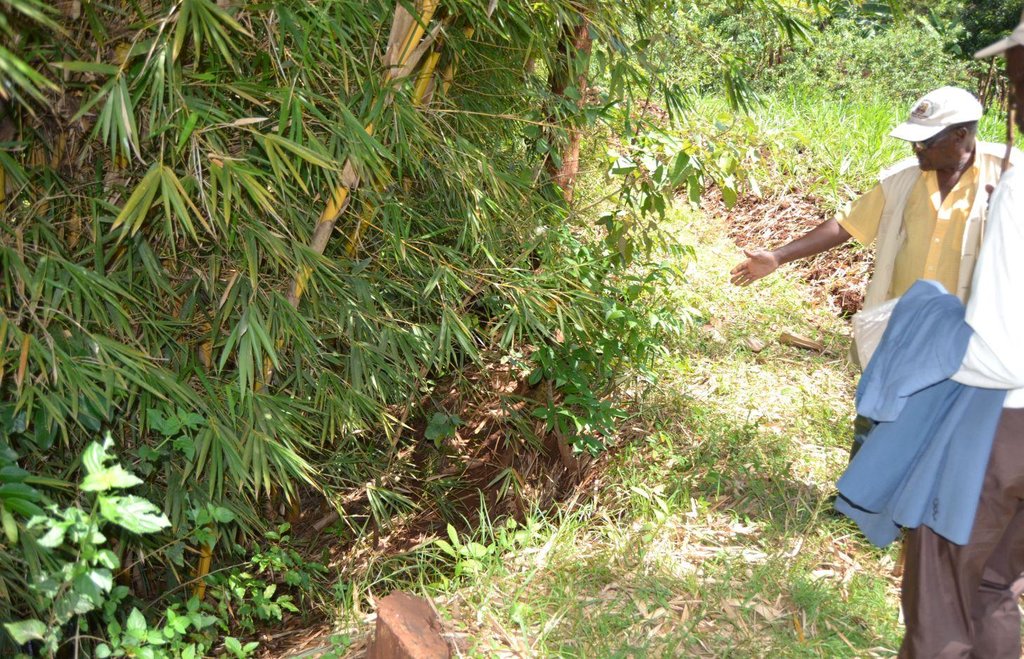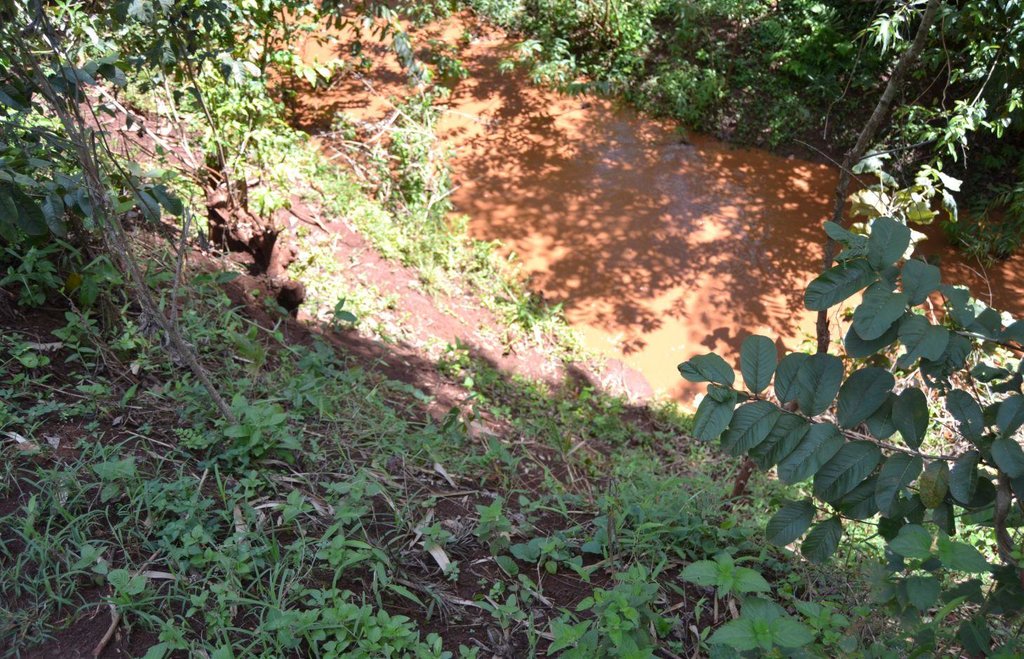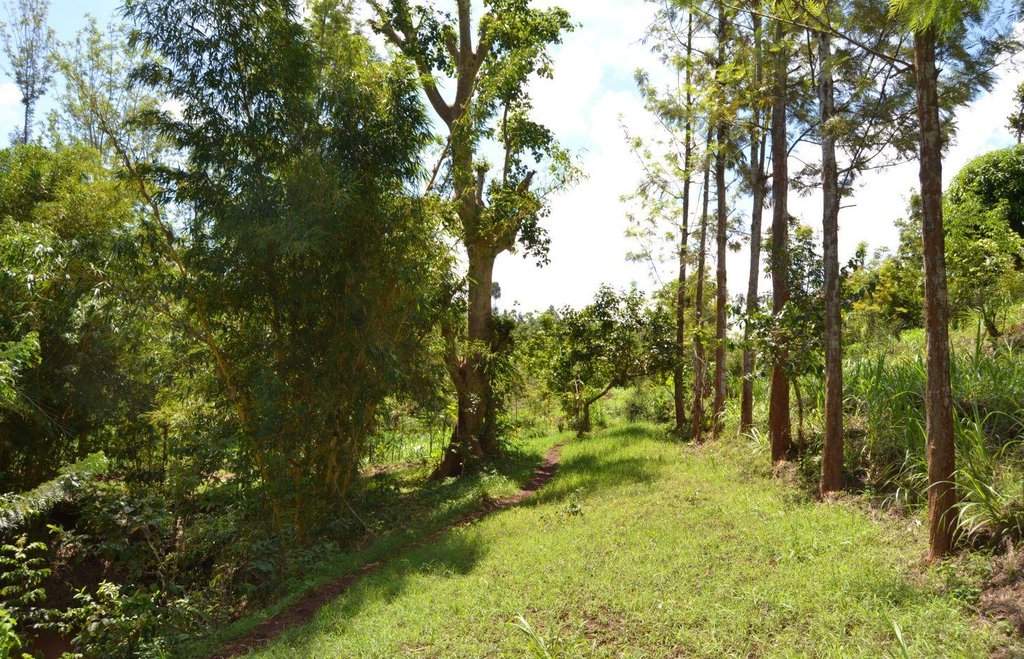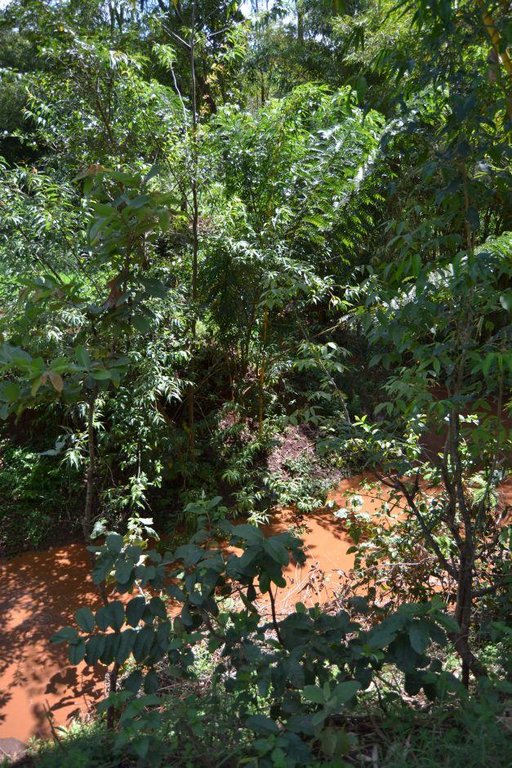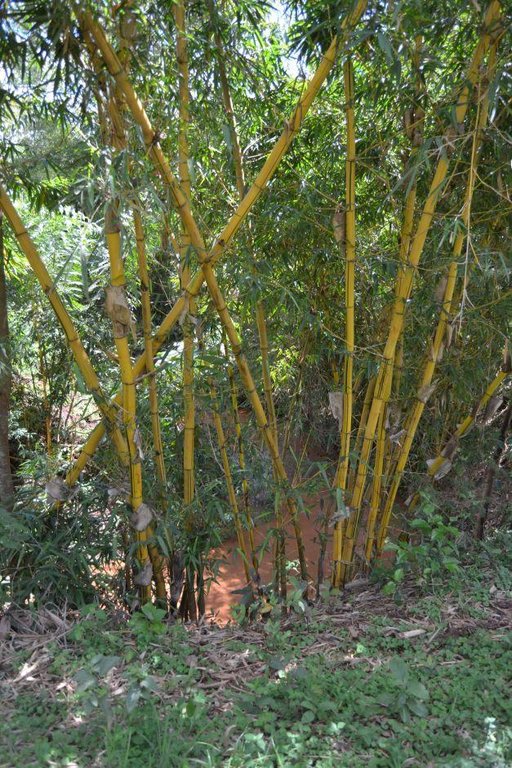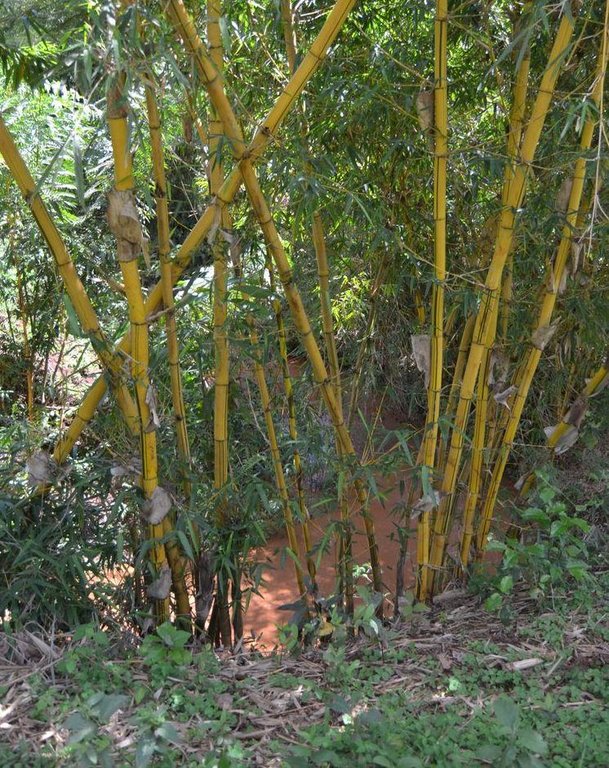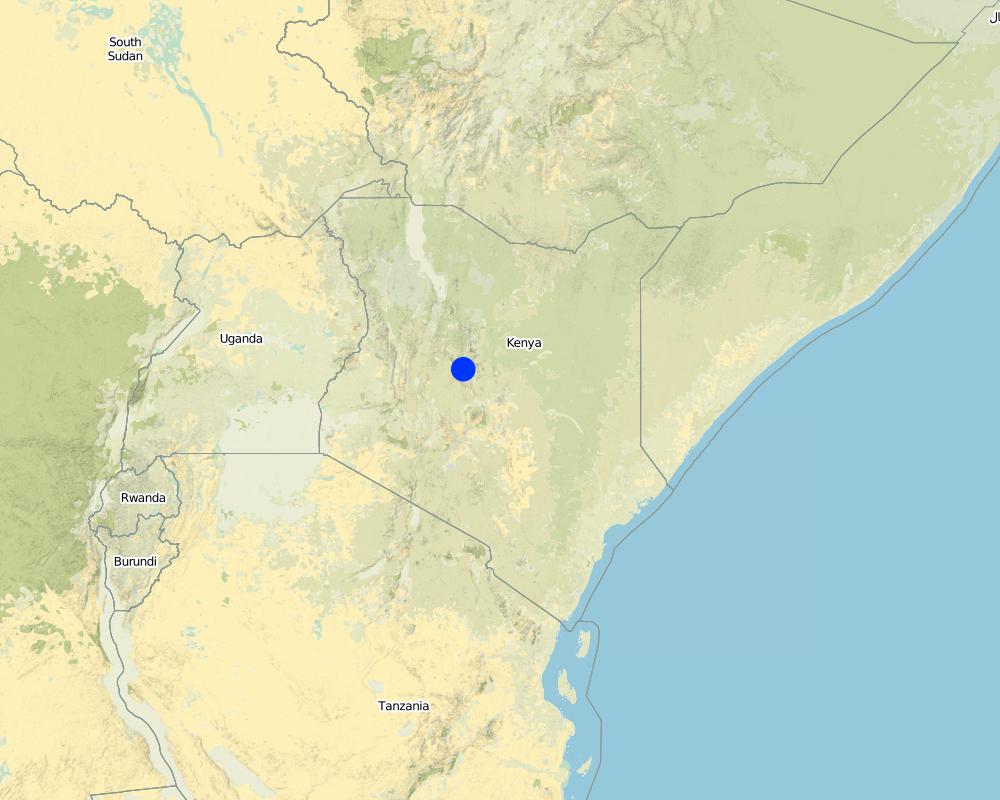Planting Bamboes and Grevillea for Riparian Land Conservation [เคนยา]
- ผู้สร้างสรรค์:
- การอัพเดท:
- ผู้รวบรวม: Laura D'Aietti
- ผู้เรียบเรียง: –
- ผู้ตรวจสอบ: David Streiff, Alexandra Gavilano
technologies_1135 - เคนยา
ดูส่วนย่อย
ขยายทั้งหมด ย่อทั้งหมด1. ข้อมูลทั่วไป
1.2 รายละเอียดที่ติดต่อได้ของผู้รวบรวมและองค์กรที่เกี่ยวข้องในการประเมินและการจัดเตรียมทำเอกสารของเทคโนโลยี
ผู้เชี่ยวชาญ SLM:
F. K. Nyamu Joseph
Saba Saba WRUA
เคนยา
ชื่อขององค์กรซึ่งอำนวยความสะดวกในการทำเอกสารหรือการประเมินเทคโนโลยี (ถ้าเกี่ยวข้อง)
FAO Food and Agriculture Organization (FAO Food and Agriculture Organization) - อิตาลีชื่อขององค์กรซึ่งอำนวยความสะดวกในการทำเอกสารหรือการประเมินเทคโนโลยี (ถ้าเกี่ยวข้อง)
Saba Saba Water Resource Users Association (Saba Saba WRUA) - เคนยา1.3 เงื่อนไขการใช้ข้อมูลที่ได้บันทึกผ่านทาง WOCAT
ผู้รวบรวมและวิทยากรหลักยอมรับเงื่อนไขเกี่ยวกับการใช้ข้อมูลที่ถูกบันทึกผ่านทาง WOCAT:
ใช่
2. การอธิบายลักษณะของเทคโนโลยี SLM
2.1 การอธิบายแบบสั้น ๆ ของเทคโนโลยี
คำจำกัดความของเทคโนโลยี:
The technology is based on tree plantation of several species (i.e. Grevillea robusta, Psidium guava, Bambusa vulgaris ) along the riparian land of the farmer.
2.2 การอธิบายแบบละเอียดของเทคโนโลยี
คำอธิบาย:
The practice carried out voluntary by the farmer consists of planting trees at the edge of the river bank and in its proximity.
Purpose of the Technology: By increasing vegetation cover (started 10 year ago) the intention of the farmer is to reduce and control bank erosion and landslides in the riparian land.
The degradation in this area is in fact evident and it is partially explained by the reduced vegetative cover. The planted trees help to maintain water quality by filtering silt and organic materials from rainwater runoff from the upper area and at the same time reinforce the streambank to control erosion. Another important environmental benefit is the increased carbon allocation from the new root systems.
The farmer also mentioned the interest to continue expanding tree plantation also in view of carbon credit and financial support from local authorities: in particular bamboo, which reaches maturity in few years, can be harvested after about two years and is easy to propagate (vegetatively).
Grevillea trees (timber) are seen by the farmer as a form of saving, and sold out when the farmer is in need of cash, earning between 800 up to 1500 KSh (Kenyan Shillings), depending on the size of the tree and the costs for cutting- transportation (e.g. machine operator between 500-700 KSh).
Establishment / maintenance activities and inputs: The initial inputs for the establishment of the vegetative practices concern mainly labour (e.g. planting trees) and the cost of the seedlings (10 KSh seedlings of Grevillea, 20 KSh of Guava); generally these activities are carried out at the beginning of the rainy season. Pruning of Grevillea is done every three seasons.
Natural / human environment: The climate is sub humid with two rainy seasons (the first starts around March and the second around October). Near the river the area is characterized by gentle slope and deposition of sediments and bank erosion are the main processes; the risks of further degradation and water pollution are reduced by the riparian vegetation and thanks to the good land management practices of the surrounding farmers. The riparian land is the area of min 6-30 m around the river and it is considered by law a protected area; therefore it should be left intact from any human activity (Water Act, 2002). Indeed, the 'control' and daily management is carried out by the riparian farmers in collaboration with Sabasaba WRUA and WRMA, the official authority for the management of the water of the river and the riparian land.
In this site in particular, the water of the river is considered clean by the farmer interviewed, despite the fact that during rainy seasons the sediment loads affect the quality of the water.
2.3 รูปภาพของเทคโนโลยี
2.5 ประเทศภูมิภาค หรือสถานที่ตั้งที่เทคโนโลยีได้นำไปใช้และได้รับการครอบคลุมโดยการประเมินนี้
ประเทศ:
เคนยา
ภูมิภาค/รัฐ/จังหวัด:
Kenya
ข้อมูลจำเพาะเพิ่มเติมของสถานที่ตั้ง :
GATWAMIKWA village, Kagurumo sublocation, Muthithi location
แสดงความคิดเห็น:
Total area covered by the SLM Technology is 0,1 ha m2.
Map
×2.6 วันที่การดำเนินการ
ถ้าไม่รู้ปีที่แน่นอน ให้ระบุวันที่โดยประมาณ:
- น้อยกว่า 10 ปี (ไม่นานนี้)
2.7 คำแนะนำของเทคโนโลยี
ให้ระบุว่าเทคโนโลยีถูกแนะนำเข้ามาอย่างไร:
- ด้วยการริเริ่มของผู้ใช้ที่ดินเอง
ความคิดเห็น (ประเภทของโครงการ เป็นต้น) :
Since year 2000 the farmer has been adopted SWC practices: this in reply to the prolonged degrading situation at the hedge of the river: 'natural vegetation was 'not good' and so 'it was no properly holding the soil', he said.
3. การจัดประเภทของเทคโนโลยี SLM
3.1 วัตถุประสงค์หลักของเทคโนโลยี
- ลด ป้องกัน ฟื้นฟู การเสื่อมโทรมของที่ดิน
3.2 ประเภทของการใช้ที่ดินในปัจจุบันที่ได้นำเทคโนโลยีไปใช้

พื้นที่ปลูกพืช
- การปลูกไม้ยืนต้น ไม้พุ่ม
Tree and shrub cropping - Specify crops:
- mango, mangosteen, guava
จำนวนของฤดูเพาะปลูกต่อปี:
- 2
ระบุ:
Longest growing period in days: 122 Longest growing period from month to month: from about March to June Second longest growing period in days: 61 Second longest growing period from month to month: from about October to November

ป่า/พื้นที่ทำไม้
- few lines of Grevillea/Bamboes (According to the definitions adopted FAO (FRA, 2010) the land could not be considered as wooded land (less than 0.5 ha).)
Type of tree:
- Bamboo bamboo
- Grevillea robusta
ผลิตภัณฑ์และบริการ:
- การอนุรักษ์ / ป้องกันธรรมชาติ
- source of cash
แสดงความคิดเห็น:
Tree plantation of several species (i.e. Grevillea robusta, Psidium guava, Bambusa vulgaris )
Major land use problems (compiler’s opinion): Risk of bank erosion and deposition of sediments in the river. See Appendix 3. Fig. 2.
Major land use problems (land users’ perception): Bank erosion. See Appendix 3. Fig. 3
Other type of forest: few lines of Grevillea/Bamboes: According to the definitions adopted FAO (FRA, 2010) the land could not be considered as wooded land (less than 0.5 ha).
Problems / comments regarding forest use: Bamboos are planted because of environmental benefits of this plant to stabilize riverbank. Other potential uses: e.g. wood is used to make baskets, fences and various kind of construction; leaves are used to feed chickens. The hollow sections between nodes are used to make containers. Indeed, the farmer let neighbours to clear and use some bamboos.
Forest products and services: nature conservation / protection
Other forest products and services: source of cash
3.5 กลุ่ม SLM ที่ตรงกับเทคโนโลยีนี้
- การปรับปรุงดิน / พืชคลุมดิน
- การปรับปรุงพันธุ์พืชหรือพันธุ์สัตว์ต่าง ๆ
3.6 มาตรการ SLM ที่ประกอบกันเป็นเทคโนโลยี

มาตรการจัดการพืช
- A7: Others

มาตรการอนุรักษ์ด้วยวิธีพืช
- V1: ต้นไม้และพุ่มไม้คลุมดิน
แสดงความคิดเห็น:
Main measures: vegetative measures
Secondary measures: agronomic measures
Type of vegetative measures: aligned: -along boundary, scattered / dispersed
3.7 รูปแบบหลักของการเสื่อมโทรมของที่ดินที่ได้รับการแก้ไขโดยเทคโนโลยี

การกัดกร่อนของดินโดยน้ำ
- Wm (Mass movement): การเคลื่อนตัวของมวลดินหรือดินถล่ม
- Wr (Riverbank erosion): การกัดกร่อนริมฝั่งแม่น้ำ

การเสื่อมโทรมของน้ำ
- Hp (Decline of surface water quality): การลดลงของคุณภาพน้ำที่ผิวดิน
แสดงความคิดเห็น:
Main type of degradation addressed: Wr: riverbank erosion, Hp: decline of surface water quality
Secondary types of degradation addressed: Wm: mass movements / landslides
Main causes of degradation: deforestation / removal of natural vegetation (incl. forest fires) (Poor vegetation cover, mainly herbaceous), Heavy / extreme rainfall (intensity/amounts) (Especially during wet seasons: March-June and October-November)
Secondary causes of degradation: other natural causes (avalanches, volcanic eruptions, mud flows, highly susceptible natural resources, extreme topography, etc.) specify (Footslope area (sediments deposition)), land tenure (Previous poor management SWC measures, especially in the upper areas)
3.8 การป้องกัน การลดลง หรือการฟื้นฟูความเสื่อมโทรมของที่ดิน
ระบุเป้าหมายของเทคโนโลยีกับความเสื่อมโทรมของที่ดิน:
- ป้องกันความเสื่อมโทรมของที่ดิน
- ลดความเสื่อมโทรมของดิน
แสดงความคิดเห็น:
Secondary goals: prevention of land degradation
4. ข้อมูลจำเพาะด้านเทคนิค กิจกรรมการนำไปปฏิบัติใช้ ปัจจัยนำเข้า และค่าใช้จ่าย
4.1 แบบแปลนทางเทคนิคของเทคโนโลยี
ข้อมูลจำเพาะด้านเทคนิค (แบบแปลนทางเทคนิคของเทคโนโลยี):
Bamboos planted at the hedge of the river; a line of Grevillea, which demarcate the farmer's property and Guava seedlings planted in the riparian land.
Technical knowledge required for land users: low (E.g. Planting bamboos is easy since colony species which use rhizome to spread.)
Main technical functions: control of dispersed runoff: impede / retard, improvement of ground cover, stabilisation of soil (eg by tree roots against land slides), improvement of water quality, buffering / filtering water
Secondary technical functions: improvement of topsoil structure (compaction), increase of infiltration, increase / maintain water stored in soil, sediment retention / trapping, sediment harvesting, promotion of vegetation species and varieties (quality, eg palatable fodder)
Aligned: -along boundary
Vegetative material: T : trees / shrubs
Number of plants per (ha): 25
Vertical interval within rows / strips / blocks (m): 1.5
Width within rows / strips / blocks (m): 0.5
Scattered / dispersed
Vegetative material: T : trees / shrubs, F : fruit trees / shrubs
Number of plants per (ha): 55
Vertical interval within rows / strips / blocks (m): few cm
Trees/ shrubs species: (25) Grevillea robusta (Mũkĩma)
Fruit trees / shrubs species: (5) Psidium guajava (Mũbera), (50 sps) Bambusa vulgaris (Mũrangi)
Slope (which determines the spacing indicated above): 3%
4.2 ข้อมูลทั่วไปเกี่ยวกับการคำนวณปัจจัยนำเข้าและค่าใช้จ่าย
ระบุสกุลเงินที่ใช้คำนวณค่าใช้จ่าย:
- USD
4.3 กิจกรรมเพื่อการจัดตั้ง
| กิจกรรม | Timing (season) | |
|---|---|---|
| 1. | Digging holes / Planting pits (1 feet×1feet Grevillea) | Beginning of the season (March/April) |
4.4 ค่าใช้จ่ายของปัจจัยนำเข้าที่จำเป็นสำหรับการจัดตั้ง
| ปัจจัยนำเข้า | หน่วย | ปริมาณ | ค่าใช้จ่ายต่อหน่วย | ค่าใช้จ่ายทั้งหมดต่อปัจจัยนำเข้า | %ของค่าใช้จ่ายที่ก่อให้เกิดขึ้นโดยผู้ใช้ที่ดิน | |
|---|---|---|---|---|---|---|
| แรงงาน | Digging holes | Persons/day | 4.0 | 1.75 | 7.0 | 100.0 |
| วัสดุด้านพืช | Seedlings Grevillea | pieces | 25.0 | 0.28 | 7.0 | 100.0 |
| วัสดุด้านพืช | Seedlings Guava | pieces | 5.0 | 0.2 | 1.0 | 100.0 |
| ค่าใช้จ่ายทั้งหมดของการจัดตั้งเทคโนโลยี | 15.0 | |||||
| Total costs for establishment of the Technology in USD | 15.0 | |||||
4.5 การบำรุงรักษาสภาพหรือกิจกรรมที่เกิดขึ้นเป็นประจำ
| กิจกรรม | ช่วงระยะเวลา/ความถี่ | |
|---|---|---|
| 1. | Pruning Grevillea and let branches dry for firewood | Every 3 seasons |
| 2. | Clearing Grevillea for sale | When in need of cash (not regularly), at least 5 years after planting |
4.6 ค่าใช้จ่ายของปัจจัยนำเข้าและกิจกรรมที่เกิดขึ้นเป็นประจำที่ต้องการการบำรุงรักษา (ต่อปี)
| ปัจจัยนำเข้า | หน่วย | ปริมาณ | ค่าใช้จ่ายต่อหน่วย | ค่าใช้จ่ายทั้งหมดต่อปัจจัยนำเข้า | %ของค่าใช้จ่ายที่ก่อให้เกิดขึ้นโดยผู้ใช้ที่ดิน | |
|---|---|---|---|---|---|---|
| แรงงาน | Pruning Grevillea | Persons/day | 1.0 | 4.0 | 4.0 | 100.0 |
| แรงงาน | Clearing Grevillea for sale | Persons/day | 1.0 | 7.0 | 7.0 | 100.0 |
| ค่าใช้จ่ายทั้งหมดของการบำรุงรักษาสภาพเทคโนโลยี | 11.0 | |||||
| Total costs for maintenance of the Technology in USD | 11.0 | |||||
แสดงความคิดเห็น:
Machinery/ tools: shovel, machete, hoe
The costs summarized above have been calculated considering one year activities; Bamboos do not require establishment/maintenance costs and therefore do not appear in the balance sheet costs.
4.7 ปัจจัยสำคัญที่สุดที่มีผลกระทบต่อค่าใช้จ่าย
ปัจจัยสำคัญที่สุดที่มีผลกระทบต่อค่าใช้จ่ายต่างๆ:
An important constraining factor is labour cost for clearing Grevillea.
5. สิ่งแวดล้อมทางธรรมชาติและของมนุษย์
5.1 ภูมิอากาศ
ฝนประจำปี
- < 250 ม.ม.
- 251-500 ม.ม.
- 501-750 ม.ม.
- 751-1,000 ม.ม.
- 1,001-1,500 ม.ม.
- 1,501-2,000 ม.ม.
- 2,001-3,000 ม.ม.
- 3,001-4,000 ม.ม.
- > 4,000 ม.ม.
ข้อมูลจำเพาะ/ความคิดเห็นเรื่องปริมาณน้ำฝน:
Two wet seasons: March-June and October-November. Dry periods: December- February and July- October
เขตภูมิอากาศเกษตร
- กึ่งชุ่มชื้น
Thermal climate class: subtropics. June, July and August
5.2 สภาพภูมิประเทศ
ค่าเฉลี่ยความลาดชัน:
- ราบเรียบ (0-2%)
- ลาดที่ไม่ชัน (3-5%)
- ปานกลาง (6-10%)
- เป็นลูกคลื่น (11-15%)
- เป็นเนิน (16-30%)
- ชัน (31-60%)
- ชันมาก (>60%)
ธรณีสัณฐาน:
- ที่ราบสูง/ที่ราบ
- สันเขา
- ไหล่เขา
- ไหล่เนินเขา
- ตีนเนิน
- หุบเขา
ระดับความสูง:
- 0-100 เมตร
- 101-500 เมตร
- 501-1,000 เมตร
- 1,001-1,500 เมตร
- 1,501-2,000 เมตร
- 2,001-2,500 เมตร
- 2,501-3,000 เมตร
- 3,001-4,000 เมตร
- > 4,000 เมตร
ความคิดเห็นและข้อมูลจำเพาะเพิ่มเติมเรื่องสภาพภูมิประเทศ:
Altitudinal zone: 1434 m a.s.l.
Landforms: Footslopes are the the areas in which this technology has maximum extent.
Slopes on average: Gentle in the riparian land.
5.3 ดิน
ค่าเฉลี่ยความลึกของดิน:
- ตื้นมาก (0-20 ซ.ม.)
- ตื้น (21-50 ซ.ม.)
- ลึกปานกลาง (51-80 ซ.ม.)
- ลึก (81-120 ซ.ม.)
- ลึกมาก (>120 ซ.ม.)
เนื้อดิน (ดินชั้นบน):
- ปานกลาง (ดินร่วน ทรายแป้ง)
อินทรียวัตถุในดิน:
- ต่ำ (<1%)
(ถ้ามี) ให้แนบคำอธิบายเรื่องดินแบบเต็มหรือระบุข้อมูลที่มีอยู่ เช่น ชนิดของดิน ค่า pH ของดินหรือความเป็นกรดของดิน ความสามารถในการแลกเปลี่ยนประจุบวก ไนโตรเจน ความเค็ม เป็นต้น:
Soil fertility is low
Soil drainage / infiltration is medium
Soil water storage capacity is medium
5.4 ความเป็นประโยชน์และคุณภาพของน้ำ
ระดับน้ำใต้ดิน:
> 50 เมตร
น้ำไหลบ่าที่ผิวดิน:
ปานกลาง
คุณภาพน้ำ (ที่ยังไม่ได้บำบัด):
เป็นน้ำเพื่อการดื่มที่ดี
5.5 ความหลากหลายทางชีวภาพ
ความหลากหลายทางชนิดพันธุ์:
- ปานกลาง
5.6 ลักษณะของผู้ใช้ที่ดินที่นำเทคโนโลยีไปปฏิบัติใช้
แนวทางการตลาดของระบบการผลิต:
- ทำการค้า/การตลาด
รายได้ที่มาจากนอกฟาร์ม:
- > 50% ของรายได้ทั้งหมด
ระดับของความมั่งคั่งโดยเปรียบเทียบ:
- รวย
เป็นรายบุคคล/ครัวเรือน:
- เป็นรายบุคคล/ครัวเรือน
ระบุลักษณะอื่นๆที่เกี่ยวข้องของผู้ใช้ที่ดิน:
Population density: 10-50 persons/km2
Annual population growth: 2% - 3%
Off-farm income specification: The farmer is rich because he owns 3 acre of land and livestock, assets (electricity) which are above the average standards of the community. The farmer is retired from an accountancy service position several years ago.
Market orientation of production system: Timber of Grevillea is sold in feet.
5.7 Average area of land used by land users applying the Technology
- < 0.5 เฮกตาร์
- 0.5-1 เฮกตาร์
- 1-2 เฮกตาร์
- 2-5 เฮกตาร์
- 5-15 เฮกตาร์
- 15-50 เฮกตาร์
- 50-100 เฮกตาร์
- 100-500 เฮกตาร์
- 500-1,000 เฮกตาร์
- 1,000-10,000 เฮกตาร์
- >10,000 เฮกตาร์
แสดงความคิดเห็น:
The area for planting Grevillea is just a strip along the riparian land.
5.8 กรรมสิทธิ์ในที่ดิน สิทธิในการใช้ที่ดินและสิทธิในการใช้น้ำ
กรรมสิทธิ์ในที่ดิน:
- รายบุคคล ได้รับสิทธิครอบครอง
สิทธิในการใช้ที่ดิน:
- รายบุคคล
สิทธิในการใช้น้ำ:
- เข้าถึงได้แบบเปิด (ไม่ได้จัดระเบียบ)
แสดงความคิดเห็น:
Water use rights depend on the use: open access for drinking and domestic uses.
5.9 การเข้าถึงบริการและโครงสร้างพื้นฐาน
สุขภาพ:
- จน
- ปานกลาง
- ดี
การศึกษา:
- จน
- ปานกลาง
- ดี
ความช่วยเหลือทางด้านเทคนิค:
- จน
- ปานกลาง
- ดี
การจ้างงาน (เช่น ภายนอกฟาร์ม):
- จน
- ปานกลาง
- ดี
ตลาด:
- จน
- ปานกลาง
- ดี
พลังงาน:
- จน
- ปานกลาง
- ดี
ถนนและการขนส่ง:
- จน
- ปานกลาง
- ดี
น้ำดื่มและการสุขาภิบาล:
- จน
- ปานกลาง
- ดี
บริการด้านการเงิน:
- จน
- ปานกลาง
- ดี
6. ผลกระทบและสรุปคำบอกกล่าว
6.1 ผลกระทบในพื้นที่ดำเนินการ (On-site) จากการใช้เทคโนโลยี
ผลกระทบทางด้านเศรษฐกิจและสังคม
การผลิต
การผลิตพืชที่ใช้เลี้ยงปศุสัตว์
การผลิตไม้
พื้นที่สำหรับการผลิต
ความเป็นประโยชน์และคุณภาพของน้ำ
การมีน้ำไว้ให้สำหรับการชลประทาน
แสดงความคิดเห็น/ระบุ:
Could be the case for Napier grass if long dry spells occur
ความต้องการน้ำจากการชลประทาน
รายได้และค่าใช้จ่าย
ค่าใช่จ่ายของปัจจัยการผลิตทางการเกษตร
รายได้จากฟาร์ม
ความหลากหลายของแหล่งผลิตรายได้
ภาระงาน
ผลกระทบด้านสังคมวัฒนธรรมอื่น ๆ
ความมั่นคงด้านอาหาร / พึ่งตนเองได้
แสดงความคิดเห็น/ระบุ:
Indirectly another source of income that could improve in maintaining FS conditions at household level
สถาบันของชุมชน
แสดงความคิดเห็น/ระบุ:
The shared knowledge/benefits help to build community solidarity, strengthening linkages between farmers
SLM หรือความรู้เรื่องความเสื่อมโทรมของที่ดิน
แสดงความคิดเห็น/ระบุ:
The importance of the benefits of Bamboos and other sps. to the river in preventing erosion and improving water quality has encouraged neighbours to adopt the same veg. measures (fig. 8)
ผลกระทบด้านนิเวศวิทยา
วัฐจักรน้ำหรือน้ำบ่า
คุณภาพน้ำ
น้ำไหลบ่าที่ผิวดิน
การระเหย
ดิน
ความชื้นในดิน
สิ่งปกคลุมดิน
การสูญเสียดิน
ความหลากหลายทางชีวภาพของพืชและสัตว์
มวลชีวภาพ/เหนือดินชั้น C
ความหลากหลายของสัตว์
แสดงความคิดเห็น/ระบุ:
Especially Bamboo's canopy which create a good habitat for birds
การจัดการศัตรูพืชและโรคพืช
แสดงความคิดเห็น/ระบุ:
Expanding bamboo's plantation could attract rodents/rats feeded off the bamboo's fruits, grains.
ผลกระทบด้านนิเวศวิทยาอื่น ๆ
Carbon credit
แสดงความคิดเห็น/ระบุ:
Beginning phase of the process of acquiring CC.
6.2 ผลกระทบนอกพื้นที่ดำเนินการ (Off-site) จากการใช้เทคโนโลยี
น้ำที่ใช้ประโยชน์ได้
การไหลของน้ำคงที่และสม่ำเสมอในช่วงฤดูแล้ง
การทับถมของดินตะกอนพื้นที่ท้ายน้ำ
การเกิดมลพิษในน้ำบาดาลหรือแม่น้ำ
ความสามารถต้านทานการเปลี่ยนแปลง / ความสามารถในการคัดกรอง
6.3 การเผชิญและความตอบสนองของเทคโนโลยีต่อการเปลี่ยนแปลงสภาพภูมิอากาศที่ค่อยเป็นค่อยไป และสภาพรุนแรงของภูมิอากาศ / ภัยพิบัติ (ที่รับรู้ได้โดยผู้ใช้ที่ดิน)
การเปลี่ยนแปลงสภาพภูมิอากาศที่ค่อยเป็นค่อยไป
การเปลี่ยนแปลงสภาพภูมิอากาศที่ค่อยเป็นค่อยไป
| ฤดู | increase or decrease | เทคโนโลยีมีวิธีการรับมืออย่างไร | |
|---|---|---|---|
| อุณหภูมิประจำปี | เพิ่มขึ้น | ไม่ทราบ |
สภาพรุนแรงของภูมิอากาศ (ภัยพิบัติ)
ภัยพิบัติทางอุตุนิยมวิทยา
| เทคโนโลยีมีวิธีการรับมืออย่างไร | |
|---|---|
| พายุฝนประจำท้องถิ่น | ดี |
| พายุลมประจำท้องถิ่น | ดี |
ภัยพิบัติจากสภาพภูมิอากาศ
| เทคโนโลยีมีวิธีการรับมืออย่างไร | |
|---|---|
| ภัยจากฝนแล้ง | ไม่ค่อยดี |
ภัยพิบัติจากน้ำ
| เทคโนโลยีมีวิธีการรับมืออย่างไร | |
|---|---|
| น้ำท่วมตามปกติ (แม่น้ำ) | ดี |
ผลลัพธ์ตามมาที่เกี่ยวข้องกับภูมิอากาศอื่น ๆ
ผลลัพธ์ตามมาที่เกี่ยวข้องกับภูมิอากาศอื่น ๆ
| เทคโนโลยีมีวิธีการรับมืออย่างไร | |
|---|---|
| ช่วงการปลูกพืชที่ลดลงมา | ไม่ทราบ |
6.4 การวิเคราะห์ค่าใช้จ่ายและผลประโยชน์ที่ได้รับ
ผลประโยชน์ที่ได้รับเปรียบเทียบกับค่าใช้จ่ายในการจัดตั้งเป็นอย่างไร (จากมุมมองของผู้ใช้ที่ดิน)
ผลตอบแทนระยะสั้น:
เป็นกลางหรือสมดุล
ผลตอบแทนระยะยาว:
ด้านบวกเล็กน้อย
ผลประโยชน์ที่ได้รับเปรียบเทียบกับค่าใช้จ่ายในการบำรุงรักษาหรือต้นทุนที่เกิดขึ้นซ้ำอีก เป็นอย่างไร (จากมุมมองของผู้ใช้ที่ดิน)
ผลตอบแทนระยะสั้น:
เป็นกลางหรือสมดุล
ผลตอบแทนระยะยาว:
ด้านบวกเล็กน้อย
6.5 การปรับตัวของเทคโนโลยี
- ครั้งเดียวหรือเป็นการทดลอง
Of all those who have adopted the Technology, how many did so spontaneously, i.e. without receiving any material incentives/ payments?
- 0-10%
แสดงความคิดเห็น:
100% of land user families have adopted the Technology with external material support
There is a moderate trend towards spontaneous adoption of the Technology
6.7 จุดแข็ง / ข้อได้เปรียบ / โอกาสของเทคโนโลยี
| จุดแข็ง / ข้อได้เปรียบ / โอกาสในทัศนคติของผู้ใช้ที่ดิน |
|---|
|
Grevillea is good for timber producion. How can they be sustained / enhanced? More trees could be planted, but because of 'lack of money' he can not afford it. |
|
Bamboos are good in holding the soil How can they be sustained / enhanced? Leaves could be actually used to feed chickens; planting the 'giant bamboos' also for food consumption. |
| จุดแข็ง / ข้อได้เปรียบ / โอกาสในทัศนคติของผู้รวบรวมหรือวิทยากรหลัก |
|---|
|
The Technology is easy to adopt, specially Bamboos plantation, since it does not require significant input and knowledge How can they be sustained / enhanced? It could be implemented in the long run also because the farmer is willing to earmark part of his land for a nursery. The intention is to support the nursery with free seedlings, which could be later distributed among the riparian farmers of the community. |
|
Bambos spreads easily through cuttings and it has different beneficial uses (baskets, fences and various kinds of construction). How can they be sustained / enhanced? Other type of Bamboos could be used as: Dendrocalamus giganteus for food consumption and Arundinaria alpina. |
|
Grevillea plantation has benefits in holding soil. It helps to reduce evaporation from the soil since it makes good shadow. How can they be sustained / enhanced? To increase biodiversity other indigenous sps. could be also planted, among others: Croton megalocarpus (Mũkindũri) a medicinal tree that attracts a lot of bees when in flower, resulting in excellent white honey. The seeds contain oil. Sesbania sesban/keniensis (Mwethia), a nitrogen fixers plant which therefore helps to increase soil fertility. |
7. การอ้างอิงและการเชื่อมต่อ
7.1 วิธีการและแหล่งข้อมูล
7.2 การอ้างอิงถึงสิ่งตีพิมพ์
หัวข้อ, ผู้เขียน, ปี, หมายเลข ISBN:
Kikuyu botanical Dictionary 2nd Ed.:A guide to plants names, uses and cultural values. Muruga Gachathi, 2007.
ชื่อเรื่อง ผู้เขียน ปี ISBN:
KEFRI, Nairobi
7.3 Links to relevant online information
ชื่อเรื่องหรือคำอธิบาย:
Smallholder timber and firewood marketing in the coffee and cotton/tobacco zones ofeastern Mount Kenya. Holding et al., 2006.
URL:
http://www.coford.ie/media/coford/content/publications/projectreports/small-scaleforestryconference/Holding.pdf
ชื่อเรื่องหรือคำอธิบาย:
Lovett, S. & Price, P. (eds), 2007, Principles for riparian lands management, Land & Water Australia, Canberra. (Ch. 2 Diversity and dynamics of riparian vegetation, Ch.6 The influence of riparian management on stream erosion)
URL:
http://lwa.gov.au/files/products/river-landscapes/px061170/px061170-chapter-1.pdf
ชื่อเรื่องหรือคำอธิบาย:
Water Act (The), 2002. N8. The National Water Services Strategy
URL:
http://faolex.fao.org/docs/pdf/ken37553-a.pdf and http://faolex.fao.org/docs/pdf/ken37553-b.pdf
ลิงก์และโมดูล
ขยายทั้งหมด ย่อทั้งหมดลิงก์
ไม่มีลิงก์
โมดูล
ไม่มีโมดูล


